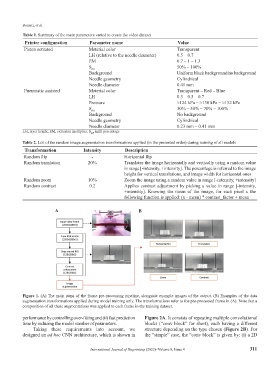Page 319 - IJB-8-4
P. 319
Bonatti, et al.
Table 1. Summary of the main parameters varied to create the video dataset
Printer configuration Parameter name Value
Piston actuated Material color Transparent
LH (relative to the needle diameter) 0.5 – 0.7
EM 0.7 – 1 – 1.3
S fill 50% – 100%
Background Uniform black background/no background
Needle geometry Cylindrical
Needle diameter 0.41 mm
Pneumatic assisted Material color Transparent – Red – Blue
LH 0.3 – 0.5 – 0.7
Pressure ≈124 kPa – ≈138 kPa – ≈152 kPa
S fill 30% – 50% – 70% – 100%
Background No background
Needle geometry Cylindrical
Needle diameter 0.23 mm – 0.41 mm
LH, layer height; EM, extrusion multiplier; S , infill percentage
fill
Table 2. List of the random image augmentation transformations applied (in the presented order) during training of all models
Transformation Intensity Description
Random flip - Horizontal flip
Random translation 20% Translates the image horizontally and vertically using a random value
in range [-intensity, +intensity]. The percentage is referred to the image
height for vertical translations, and image width for horizontal ones
Random zoom 10% Zoom the image using a random value in range [-intensity, +intensity]
Random contrast 0.2 Applies contrast adjustment by picking a value in range [-intensity,
+intensity]. Knowing the mean of the image, for each pixel x the
following function is applied: (x - mean) * contrast_factor + mean
A B
Figure 1. (A) The main steps of the frame pre-processing pipeline, alongside example images of the output. (B) Examples of the data
augmentation transformations applied during model training only. The transformations refer to the pre-processed frame in (A). Note that a
composition of all these augmentations was applied to each frame in the training dataset.
performance by controlling over-fitting and (ii) fast prediction Figure 2A. It consists of repeating multiple convolutional
time by reducing the model number of parameters. blocks (“conv block” for short), each having a different
Taking these requirements into account, we structure depending on the type chosen (Figure 2B). For
designed an ad hoc CNN architecture, which is shown in the “simple” case, the “conv block” is given by: (i) a 2D
International Journal of Bioprinting (2022)–Volume 8, Issue 4 311

